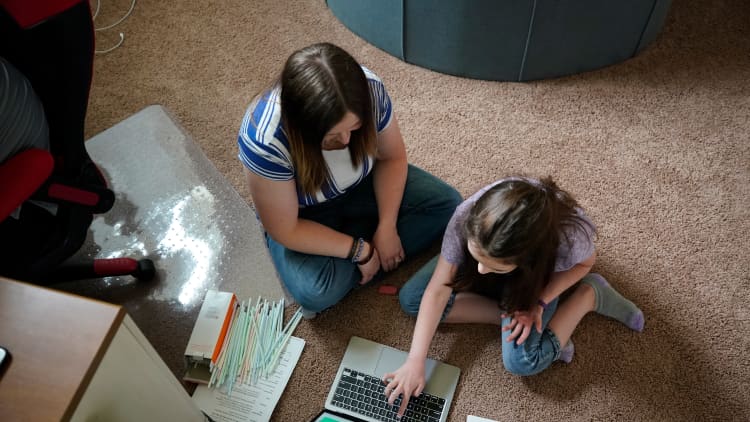Low- and middle-income families could get major child-care assistance under President Biden's tax plan.
The $1.8 trillion spending and tax credit plan set to be announced by Biden Wednesday night would spend $225 billion over a decade towards high-quality child care for children under the age of 5 and would ensure that families only pay a portion of their total income for child-care services.
Under the plan, the average American family with young children may save $14,800 a year on child care.
Low-income families would have all of their child-care expenses covered, and those that make 1.5 times their state median income would spend no more than 7% of their annual income on child-care services. Parents will have a range of child-care options to choose from under the plan.
More from Invest in You:
Young investors are betting on stocks. Here's what to know before jumping in
As home prices rise, here's what buyers can do to land a deal
Suze Orman: Here's the best way to get rid of your loans
"I like the proposal because it attempts to look at a family's whole budget," said Elaine Maag, a principal research associate at the Urban-Brookings Tax Policy Center. "So instead of saying child care is going to cost, you know, $10,000 a year or $2,000 a year, it says this share of your income should be dedicated to child care."
The proposal, which would be paid for by raising taxes on the wealthiest Americans, would also include funding for child-care providers to invest in the workforce, meaning a minimum $15 an hour wage for workers in the industry.
Why it would help
Many American families, especially those with lower incomes, spend large portions of their earnings on child care for children who are not yet in school, said Aaron Sojourner, an economist at the University of Minnesota.
The lowest-earning families can spend about a third of their income on child care, and even middle-class families spend about 14%, according to Sojourner.
"A 7% cap would be a huge benefit to families when they're really struggling and a big investment in kids' wellbeing and family wellbeing," he said, adding that the U.S. currently spends a lot more on children once they reach elementary school but very little on early childhood.
"You see these big gaps opening up between kids from low-income families and high-income families in their development, skills and capacities in the first five years of their lives," said Sojourner.

Investing in high-quality early child care would also benefit parents — and women to a great extent — who would be better able to rejoin or stay in the workforce with this support.
This is especially important considering the coronavirus pandemic, which hit industries that employed mostly women as well as people of color. In addition, because schools have been closed due to Covid, many women found themselves staying at home to help care for children instead of returning to work even as the economy has reopened.
What other child-care support is in the bill
There are other child-care stipulations in the bill, including child-care services for college students, free universal preschool for all 3- and 4-year-olds and an expansion of certain tax credits.
The enhanced child tax credit would be extended through 2025, and the temporary child and dependent care tax credit from the American Rescue Plan would become permanent, giving families a tax credit for up to half of their spending on qualified child care, such as full-time care, after school care or summer care for children under age 13.
A 7% cap would be a huge benefit to families when they're really struggling and a big investment in kids wellbeing and family wellbeingAaron SojournerEconomist, University of Minnesota
The credit is good for up to a total of $4,000 for families with one child or $8,000 for two or more children. Families making less than $125,000 per year would get the entire 50% reimbursement, while those making between $125,000 and $400,000 annually would receive a partial credit.
How it might work
It's not year clear how the child-care assistance program would be run and the plan is likely to change before being agreed upon by lawmakers.
It potentially could be implemented as a tax program, like other credits that families get when they file. It could also be administered like housing programs where the government pays a portion of the expense based on a family's income and needs.
A spending program would likely be a better help to families, according to Maag.
"We want child-care benefits to reach families when they need to pay for child care," she said. "Tax benefits, in general, reach you when you file your taxes, which can be many months later."
In addition, a spending program would give families greater flexibility to update the government if their situation changes, such as if they have another child, or become a single parent.
SIGN UP: Money 101 is an 8-week learning course to financial freedom, delivered weekly to your inbox.
CHECK OUT: How to make money with creative side hustles, from people who earn thousands on sites like Etsy and Twitch via Grow with Acorns+CNBC.
Disclosure: NBCUniversal and Comcast Ventures are investors in Acorns.






